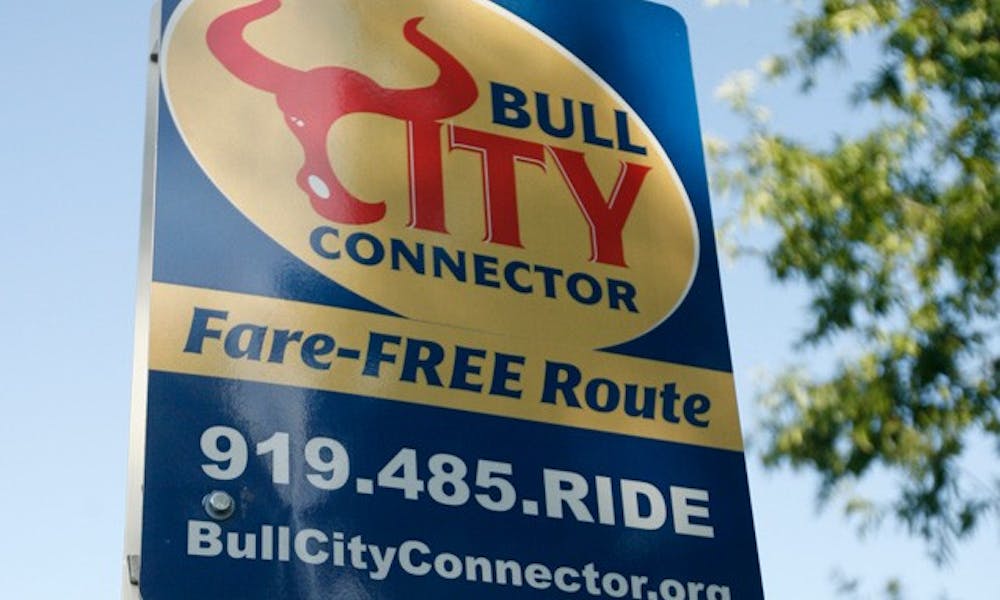Last August, the University launched a unique project with a difficult mission: connect Duke students and downtown Durham with a new bus system. One year later, Durham and school officials are evaluating the success of the Bull City Connector program and asking themselves whether students are taking full advantage of the free transportation between West Campus and the downtown area.
The University agreed to co-fund the BCC last summer in the hopes that it would encourage students to explore Durham beyond the usual venues. Phail Wynn, Duke’s vice president for Durham and regional affairs, said the University agreed to give $375,000 to the BCC after Rep. David Price, D-N.C., secured a $3 million federal grant to fund the new bus system. Although officials originally hoped the buses would serve approximately 2,000 riders a day, Wynn said daily ridership is roughly 1,500. And instead of Duke students, most of the riders appear to be locals, particularly Duke employees going to and from work.
“I think we have a lot of work to do,” Wynn said. “I don’t think we have successfully conveyed to students the convenience of the Bull City Connector and made them aware of the Bull City Connector, so we have to work next year to make students aware of its flexibility and convenience.”
Despite ridership falling short of previously stated goals, Durham’s Public Affairs Director Beverly Thompson wrote in an email that she still believes the service has moved closer to its initial goals.
“While the ridership has not reached our goal for the first year, the service has certainly accomplished the goal of connecting Duke to downtown Durham,” Thompson said. “Now we just need to make more people aware of the details about the service.”
Some students took full advantage of the BCC last year and welcomed its installment on Duke’s campus. Sarah Goetz, Trinity ’11, wrote in an email that while the Duke buses are convenient for most students, she found it difficult getting from her apartment on Central Campus to work at Smith Warehouse. The BCC not only offered her an easier way to get to work, she said, but also a way to see Durham from another perspective.
“I used it every day of my senior year cutting my commute from 20 minutes to two minutes,” Goetz said. “The best part about the bus, other than the time it saved me, was stepping out of the Duke community for a bit every day. Though the ride was short, I’ve had quite a few great conversations on the bus.”
Junior Alex Swain, Duke Student Government vice president for Durham and regional affairs, noted that many students are unaware of the BCC’s advantages. Swain wrote in an e-mail that getting the word out about the service will be on DSG’s agenda for the 2011-2012 academic year.
“Although the program is new, increasing student ridership of the BCC should be and is on the minds of the University’s administration because it is such a wonderful resource to students,” Swain said. “The Durham and regional affairs committee of DSG will be looking into doing our part to reach the goal of increased student ridership.”
Specifically, Swain advocated incorporating the BCC into first-year orientation programs and publications distributed by the Office of New Student and Family Programs.
Incoming freshman Trish Ike wrote in an email that a free bus service would be a great way to see Durham once she arrives on campus.
“We all come from different parts of the United States and even different parts of the world,” Ike said. “With this in mind, I believe having the opportunity to explore Durham will definitely give us students a broad exposure to different types of environments and communities that exist around us.”
Wynn noted that Duke’s initial financial commitment to the BCC consists of a two-year contract totaling $650,000 in University funds. Working in collaboration with the city, Wynn said Duke is actively trying to improve the quality of the service and make Duke’s collaboration with the city worthwhile.
“We want the second year to be a better year and for the numbers to get up from where we set our goal,” he said. “We are still trying to gather data about each of the pick-up and drop-off points... so we can reduce the wait time where there is more traffic.”
Bus riders have ideas about how to improve the service as well. While the BCC allowed Goetz to experience parts of the city that would have been otherwise out of reach, she said adding a more frequent weekend service could motivate students to get off campus and into the Durham community.
“If it could have extended hours on Friday and Saturday, and run at all on Sunday, it would give students an outlet for the brilliant food and music culture of Durham and tell them that it doesn’t end at the gates of Campus Drive,” she said.
A world that extends beyond Campus Drive is exactly what Ike hopes the BCC will help her experience come this Fall.
“I think that college should not be a world onto itself and everyone should take the advantage to explore the realms beyond campus,” she said. “I would highly take advantage of the free transportation system and explore Durham to observe the different cultures, customs and fun things I can embrace during my four years at Duke.”
Get The Chronicle straight to your inbox
Signup for our weekly newsletter. Cancel at any time.

